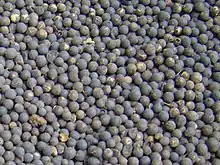| Embelia ribes | |
|---|---|
 | |
| Embelia ribes seeds | |
| Scientific classification | |
| Kingdom: | Plantae |
| Clade: | Tracheophytes |
| Clade: | Angiosperms |
| Clade: | Eudicots |
| Clade: | Asterids |
| Order: | Ericales |
| Family: | Primulaceae |
| Genus: | Embelia |
| Species: | E. ribes |
| Binomial name | |
| Embelia ribes | |
Embelia ribes, commonly known as false black pepper, white-flowered embelia, viḍaṅga (Sanskrit: विडङ्ग), vaividang, vai vidang, or vavding, jantughna, krmighna, krmihara, krmiripu, vidang, vavding, vavading, vayavadang, vayavidanga, bhabhiranga, baberang, vayuvilanga, babading, vizhalari, bidanga, babrung, vavaring, vayuvilangam, vayuvidangam, vayuvidangalu, baobarang, babrang[1] is a species in the family Primulaceae. It was originally described by Nicolaas Laurens Burman in his 1768 publication Flora Indica.[2] It is widely distributed throughout India. In Ayurveda and Siddha, it is considered widely beneficial in a variety of diseases[3] In particular embelin isolated from dried berries of Embelia ribes has a wide spectrum of biological activities.
Uses of embelia[4]:
- Intestinal worms. Used to treat various types of worm infestation in the gut.
- Indigestion. Helps with digestive issues like vomiting, nausea and constipation.
- Depression. Embelia ribes has antidepressant effects and is used to treat depression.
- Throat infection. Effective in reducing cough and treating throat infections.
- Obesity. Aids in weight loss and helps remove body toxins.
- Skin disease. Used to treat skin diseases by purifying the blood.
References
- ↑ "Sorting Embelia names". Multilingual Multiscript Plant Database. The University of Melbourne. Retrieved 2009-08-11.
- ↑ "Embelia ribes". International Plant Names Index (IPNI). Royal Botanic Gardens, Kew; Harvard University Herbaria & Libraries; Australian National Botanic Gardens. Retrieved 13 October 2009.
- ↑ http://results2.ap.nic.in/general/plants/plshow.jsp?scode=1084&pln=VIDANGA%5B%5D
- ↑ "Importance of Embelia Ribes: An Update | International Journal of Pharmaceutical Sciences and Research". October 2013.
External links
- Jalalpure SS; Alagawadi KR; Mahajanashetti, Shah BN; Salahuddin; Singh V; Patil JK, "In Vitro Anthelmintic Property of Various Seeds Oils Against Pheritima posthuma", Indian Journal of Pharmaceutical Sciences. 2007 Jan-Feb; 69(1): 158-0
- Caldecott, Todd (2006). Ayurveda: The Divine Science of Life. Elsevier/Mosby. ISBN 0-7234-3410-7. Contains a detailed monograph on Embelia ribes (vidanga), as well as a discussion of health benefits and usage in clinical practice. Available online at https://web.archive.org/web/20120620164521/http://www.toddcaldecott.com/index.php/herbs/learning-herbs/343-vidanga